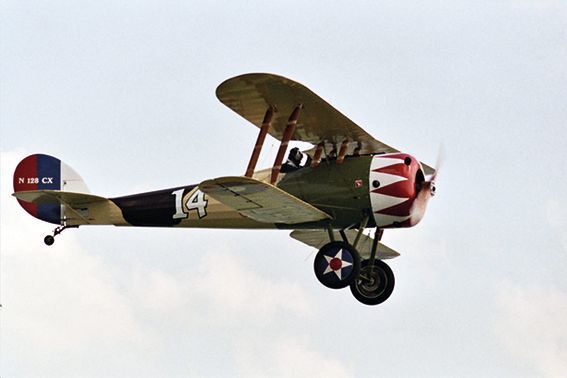
Nieuport 28
In mid 1917 it became clear that the Nieuport 17 and 24(bis) had had their day and could not compete with the better German fighters.
The Nieuport 28 was designed by Gustave Delage. The design is in line with its predecessors such as the successful Nieuport 17.
The French Aéronautique Militaire thought the performance of the Nieuport 27 was insufficient and opted for the SPAD XIII. This aircraft was also the first choice of the Americans. Due to high demand, however, there was a shortage of Spads and so 4 squadrons of the American Expeditionary Force were equipped with Nieuport 28.
It was also the type that achieved the first victory in an air battle in an American unit.
After the war, fifty aircraft found their way to America. Twelve were used by the Navy between 1919 and 1921. Others went to the US Army. The rest went to civil aviation and was used in racing and Hollywood movies.
Our Nieuport 28 is painted in the colours of the American 94th Aero Squadron that fought at the front during World War I. They fought against the German Air Force, escorted bombers over enemy territory and attacked the German observation balloons.
The squadron's logo, the "Hat in the Ring", became a symbol for the Americans and the squadron became the most famous of the American squadrons at the front.
The squadron provided three air aces: Eddie Rickenbacker, who received all possible awards; Douglas Campbell, the first American-trained pilot to win a victory and Raoul Lufberry who scored seventeen victories before being shot down himself.
After the Armistice in 1918, the squadron returned to America in 1919 and became part of the United States Army Air Service in 1921.
The squadron's name comes from the phrase "Hat in the Ring".
That saying comes from the 19th century boxing world, where would-be fighters literally threw their hats into the ring to make it clear that they wanted to take part in the fight.
Stampe en Vertongen Museum vzw
Antwerp International Airport
Bus 3
B-2100 Antwerp-Deurne
Belgium
O.N. BE0447.236.613
RPR Antwerp
email: stampe@skynet.be
www.stampe.be
Opening hours individual visits
- Mon - Fri
- Closed
- Sat - Sun
- -
Closed on Easter Sunday and during August, December and January
Useful links
All rights reserved | Stampe en Vertongen Museum vzw






